Menu

Did you know that the European Union aims to cut greenhouse gas emissions by 55% by 2030? It also targets a 90% reduction by 2040 under the REPowerEU plan. This shows the urgent need for climate action worldwide, including in Ireland.
Ireland’s Environmental Protection Act responds to these challenges. It makes significant updates for fighting climate change with both mitigation and adaptation policies. For instance, Ireland has seen a rise in average air temperatures by 0.8% since 1900, bringing more rain and extreme weather. This highlights why we need strong environmental laws.
The Ireland Environmental Protection Act incorporates climate change impact readiness into our infrastructure. This act helps in moving the nation to a carbon-neutral way of working. Such a move supports sustainable growth and shields our natural spaces for the long run. It also shows Ireland’s active support for global efforts towards environmental conservation.
The Ireland Environmental Protection Act is key for looking after the nation’s environment. It includes laws to protect nature and to help make the country develop in a way that doesn’t harm the Earth. The Act follows rules on how to look after the environment that were set by Europe, helping in the long run as well as now.
The Act was made to create a strong plan for protecting the environment. It works to stop pollution, use natural resources in a smart way, and makes sure the rules about the environment are followed in Ireland. Over time, many changes have been made to the Act. These changes help the law deal with new environmental issues and use the best global practices.
Knowing the historical development of Ireland EPA helps us see how environmental protection in Ireland has changed. The start of the Environmental Protection Agency (EPA) in 1993 was crucial. This move put together the work of different local authorities into one body. So, the EPA became the chief in making sure environmental laws are followed well.
By 2014, the EPA not only grew but also united with the Radiological Protection Institute of Ireland. This joint effort covered both environmental and radiological safety. With time, the EPA was given more tasks, for example, managing how water is used and watching over big projects like waste sites and certain industries.
Not just this, the EPA checks the environment yearly and teams up with other groups to fight environmental crimes. The Ireland legislation on environment shows the EPA’s smart way to grow and meet new challenges in protecting the environment. This shows its aim to keep improving Ireland’s practices for the future.
| Year | Event | Impact |
|---|---|---|
| 1993 | Establishment of Ireland’s EPA | Centralised environmental governance |
| 2014 | EPA merges with Radiological Protection Institute | Integrated environmental and radiological oversight |
| 2019 | Additional licensing responsibilities for water abstractions | Expanded regulatory scope |
Ireland has recently updated its Environmental Protection Act. It’s a big step that aims to cut carbon, encourage sustainable growth, and lift environmental standards. These updates are key in tackling environmental worries, like the emergency national biodiversity issue in 2019. They show Ireland’s strong drive to have solid environmental rules, proving it cares about important topics.
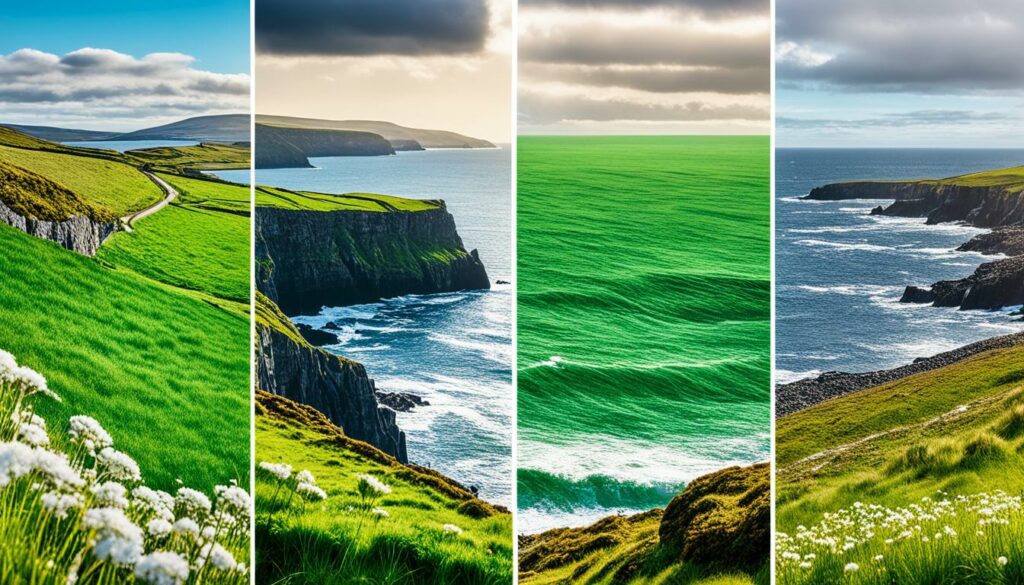
There have been several important changes to the Ireland EPA. Now, the Act pushes for a move towards an economy with less carbon. The goal is to slash CO2 emissions by 80% before 2050. Also, on 21st April, 2023, a new rule was set under the Environmental Protection Agency Acts. It was in the official publication “Iris Oifigiúil.” This rule focuses on certain activities described in the Environmental Protection Agency Act 1992.
Organisations must follow specific EPA guidelines and rules. For example, they need to let the public know in a paper two weeks before applying. They should also post notices on the site for a month. These rules are set to make the process clear and keep everyone informed.
Changes to environmental laws will be felt by many. This includes businesses, local areas, and the government. They all must deal with stricter rules that aim for a green future. More than half of Ireland’s fresh water areas are considered “poor and getting worse.” And over a third of protected species have decreasing numbers. The new Ireland EPA updates aim to tackle these big problems, pushing everyone to get greener and protect the environment better.
The changes also make it easier for certain developments to get things moving. The Environmental Protection Agency can’t give a permit without a Minister’s say. This helps bring forward around 450 MW of power quickly, meeting the needs identified by the Utilities Regulation Commission. It ensures we improve our systems while being mindful of nature through these new rules.
| Country | Environmental Legislation Milestones | Year |
|---|---|---|
| Ireland | Declared national biodiversity emergency | 2019 |
| Panama | Legislation recognising the rights of sea turtles | 2023 |
| Milwaukee County, Wisconsin | Recognised the rights of nature in October | 2023 |
The objectives of Ireland EPA are key to the country’s environmental direction. They were defined in 1993 with the start of the Environmental Protection Agency (EPA). These goals have changed over time, following new environmental regulations in Ireland and working with EU rules. This ensures a steady and strict way of looking after the environment.
The EPA handles the permission of actions like managing waste, big factory work, and farming. It also helps local officials do better. This shows Ireland’s commitment to sustainability.
Each year, the EPA checks on places that have been given permission, making sure they follow tough rules. The EPA also works with others to fight crimes against the environment and keep quality high in different places.
The Act of 1992 lays out what the EPA is to do. This includes watching the environment, doing research, and making rules for quality. The Act wants to help manage resources wisely and control pollution by doing things like checking how projects might affect the environment.
From 2018 to 2021, the River Basin Management Plan showed the EPA’s strong support for lasting practices through water use plans. The EPA also helps advise and plan, showing it plays a big part in Ireland’s sustainable and green future.
| Year | Key Developments |
|---|---|
| 1993 | Establishment of the EPA |
| 1992 | Introduction of Environmental Protection Agency Act |
| 2018-2021 | River Basin Management Plan |
In the end, the EPA’s strong plan and its wide role in guiding make Ireland’s commitment to sustainability clear. This helps move towards a green economy with low carbon.
Climate change has changed how we look at environmental protection in Ireland. It’s made us see the urgent need for policies to fight its effects. We now know we must act quickly to deal with issues both now and in the future. The Ireland Environmental Protection Act is a big step in that direction.
Ireland is facing the challenges of changing climate. We see higher temperatures and hard-hitting weather events like Storm Ophelia and the Beast from the East. These events have pushed our policies to change. We’re working hard to protect our coasts from erosion and cope with these extreme weather patterns. It shows why we need to adapt and find ways to lessen the impact of climate change in Ireland.

| Statistic | Value |
|---|---|
| Population Growth By 2040 | 1 million |
| Irish People Believing Climate Change is Happening | 96% |
| Irish People Worried About Climate Change | 85% |
Ireland is working hard on both adapting and lessening the effects of climate change. It’s making sure our buildings and land use are ready for these changes. But cutting down on how much greenhouse gas we produce is also key. This balance is crucial for a strong plan against climate change, especially when some areas show they are not adapting well.
The Act ties together both adapting and lessening our climate change impact. A strong global effort to cut emissions is crucial. It’s important that these strategies work together to make sure we’re okay in the short and long term. With 90% of Irish people ready to take action, we have a solid base of support for these measures.
Businesses in Ireland now must meet new environmental rules. These rules push for cleaner tech, lower emissions, and greener practices. The aim is to make companies more eco-conscious.
Here are some key updates under the Ireland Environmental Protection Act:
These updates support Ireland’s push for more sustainable business practices.
Not keeping up with these rules can hit businesses hard. The EPA can use many tools to enforce compliance, including:
| Enforcement Actions | Description |
|---|---|
| Notification | Formal notification of non-compliance with directives and guidelines. |
| Instructions | Specific instructions for remediation actions required from the business. |
| Prosecution | Legal action taken against the business for non-compliance issues. |
| Injunction | Legal restraint to prohibit certain harmful activities by the business. |
| License Suspension or Revocation | Temporary or permanent withdrawal of environmental permits and licenses. |
Breaking these rules is serious and aims to make businesses follow them. Staying in line with the EPA’s rules is crucial for Ireland’s economic and environmental future.
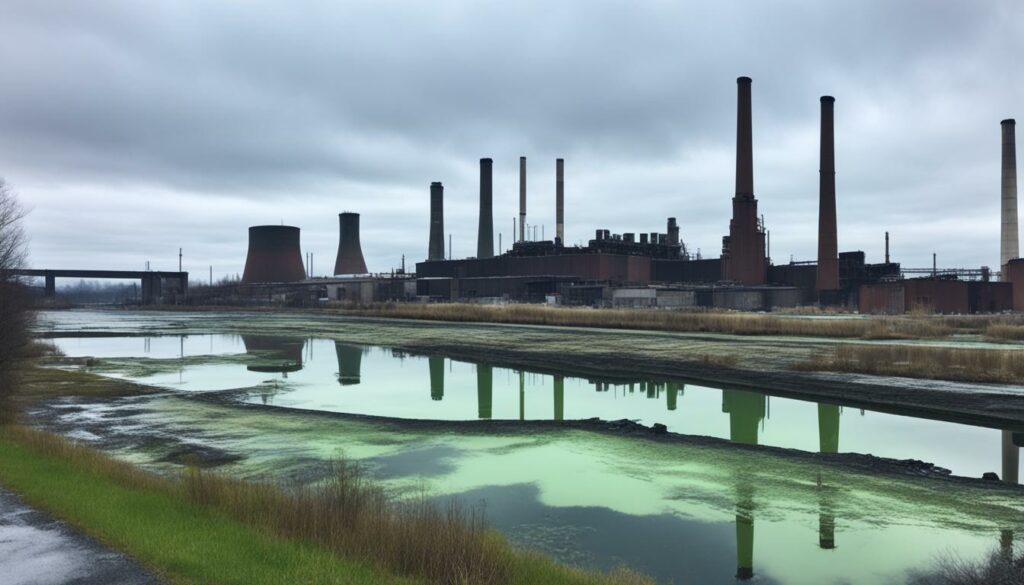
The Ireland EPA’s influence on industries is huge, thanks to new laws in the Environmental Protection Act. These rules make it clear that businesses must limit their pollution. They push for cleaner production methods to help Ireland meet its climate goals.
Ireland has set out new rules to cut down on polluting from factories. It aims to lower the harmful gases they release by up to 22% by 2030. Yet, emissions from making cement might actually go up. This change is vital to avoid breaking pollution limits in the next decade.
Being green is key for meeting Ireland’s green goals. It’s important for factories to be smarter with energy and to handle waste better. They should use methods that save money and the planet. This includes using less power and dealing with waste in a smart way.
An environmental impact assessment in Ireland is crucial for protecting the environment. It carefully checks the impact of projects. Projects under Annex I of the EIA Directive must have an EIA. Ireland’s laws also require some Annex II projects to get one if they could cause big environmental effects.
The Planning and Development Regulations 2001 (amended) include rules for Annex I and II projects. From 2020, these rules cover Integrated Pollution Control, Industrial Emissions, and more
The EPA is key in evaluating major environmental impacts. It checks projects for their pollution controls and discharge impacts. The EPA helps in major projects’ consultation and state developments, as an official adviser.
The first EIA Directive was in 1985. It has been updated several times, with the latest in 2014. Then, in 2018, new EU regulations aligned many things. Now, the system is more consistent across the EU.
The Environmental Impact Assessment Report (EIAR) is central. It is made by the project applicant. This report goes through many consultations. It ensures that experts check the projects and that the public can see and comment on them.
The National Mitigation Plan (NMP) and the National Adaptation Framework (NAF) are key parts of Ireland’s fight against climate change. They set out important actions to tackle this big issue.
Ireland’s National Mitigation Plan sets a tough goal. It wants to cut carbon dioxide emissions by 80% by 2050 from the levels in 1990. The plan also looks to make the country’s infrastructure stronger against bad weather. For example, Storm Ophelia in 2017 and the cold spell of the Beast from the East in 2018.
The adaptation framework aims to make Ireland less vulnerable to climate change. Making the country more resilient is a key aim.
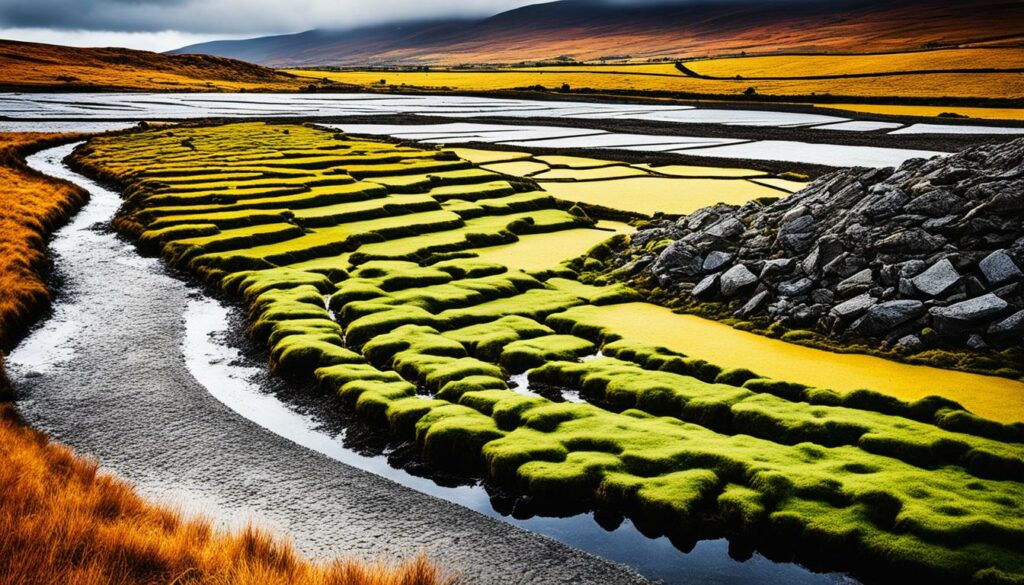
Keeping to the plan’s timeline is very important in Ireland’s fight against climate change. There are several key steps that need to be taken:
| Year | Milestone |
|---|---|
| 2018 | Publication of the first National Adaptation Framework (NAF). |
| 2019 | Release of Sectoral Adaptation Plans and 31 Local Authority Climate Adaptation Strategies. |
| 2021 | Changes to the Climate Act, including Climate Ireland moving to the EPA. |
| 2022 | There’s a review of the NAF and time for the public to give their thoughts. |
| Ongoing | They keep checking and moving forward with the plans found in the 2018 NAF. |
These set timelines help Ireland cut its greenhouse gas emissions. They make the country keep its promises, both at home and on the global stage. The country works hard to stay ahead in fighting climate change by updating its plans regularly.
The enforcement of Ireland’s environmental laws helps keep nature’s balance. It is vital for the country’s sustainable development. The Environmental Protection Agency (EPA), which started in 1992, is key here. It does expert monitoring, gives out licences, and enforces laws on many environmental issues. In 2003, it got stronger to handle pollution and other problems better.
The work the EPA does is crucial for Ireland’s natural health. It spreads the word on how to protect our world. It also helps with important research and offers key services to protect our environment.
The EPA in Ireland keeps an eye on what factories let out into the air. It makes sure they follow the rules to keep our environment safe. The EPA helps move the country towards more eco-friendly ways. It also shares important information and writes detailed reports. It checks noise levels too, among other rules.
The EPA’s system to collect environmental data and its plans for what to do over years are very important. They guide how Ireland takes care of its environment. The plans are updated every five years to keep up with new challenges.
In Ireland, the EPA uses a smart approach to watch over the environment. It checks things thoroughly and keeps everyone informed about its findings. It looks at applications for big pollution control permits carefully, considering how they affect health and nature. The EPA also talks to local authorities like An Bord Pleanala to see what’s happening with development projects. It uses high-tech methods, along with the European network, to gather and understand big amounts of environmental data.
Breaking the environmental rules in Ireland comes with tough punishments. For major water pollution, fines can be as high as €15 million. Or, someone might go to jail for up to five years. By working closely with the European Union, Ireland makes sure its environmental rules are top-notch. This bond makes Ireland even more dedicated to being eco-friendly.
The European Green Deal aims for the EU to have no emissions by 2050. Ireland is moving in line with this plan. It’s integrating the Deal into its laws.
This Deal focuses on protecting nature, growing food sustainably, and using things over again. These goals match well with Ireland’s dreams for the environment.
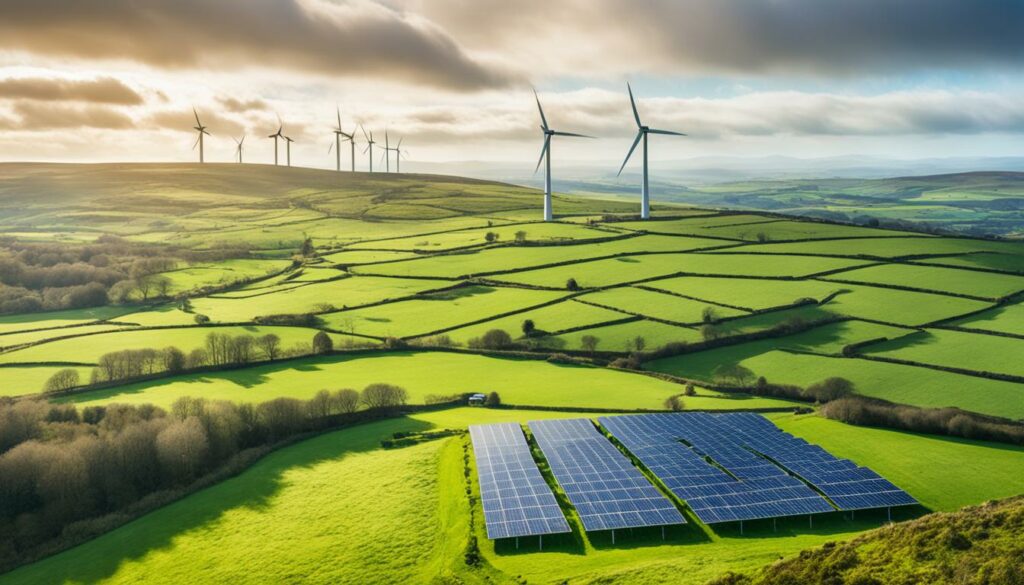
The goal is to cut greenhouse gas emissions by 55% before 2030, based on 1990 levels. This target is in both the Deal and Ireland’s laws. Also, the EU’s ‘Fit for 55’ package helps Ireland work with the EU on the environment. It sets out to improve ecosystems and use more renewable energy.
The Deal is changing Ireland’s policies to meet tough EU goals. A lot of funding from the EU goes into the Deal through the NextGenerationEU plan. This money helps communities change to more eco-friendly ways. Plus, it focuses on fighting pollution. This ties in well with Irish laws, making sure Ireland works closely with the EU on the environment.
| EU Initiative | Goal | Impact on Ireland |
|---|---|---|
| Fit for 55 | Reduce emissions by 55% by 2030 | Enhanced emission reductions across sectors |
| REPowerEU | Accelerate renewable energy deployment | Boost in renewable energy projects |
| Biodiversity Strategy 2030 | Restore 80% of ecosystems | Conservation projects and enhanced biodiversity |
| NextGenerationEU | Finance recovery and green transition | Increased funding for sustainable initiatives |
The European Green Deal brings both problems and chances for Ireland. It’s pushing Ireland to tweak its policies for these big goals. This way, Ireland will stay a top player in the EU’s environmental aims.
Getting communities involved in environmental decisions is key for the Ireland EPA. The Citizens’ Assembly in Ireland showed big community participation. 13 important recommendations on climate change came from this, based on what the public shared. This shows the strong interest and active part the public plays in environmental policy-making.
After the Citizens’ Assembly, their recommendations made it into the Oireachtas report. This report has helped find ways to push the Citizens’ Assembly ideas forward. It shows a clear process to turn public ideas into real government plans. This highlights the strong role of the public in making environmental choices.
The National Climate Action Plan in Ireland has taken on many of these ideas. It marks a great example of how to use citizen feedback in national policy. It ensures that community involvement in Ireland is recognised and used on all levels.
The National Dialogue on Climate Action (NDCA) is another great effort for community involvement. It’s led by the government and offers places to talk through forums. Here, people can address local climate issues and come up with plans, using both individual and community efforts.
Getting ideas from successful projects like the Citizens’ Assembly, Oireachtas report, and NDCA, a new plan is coming up. It wants to make future community involvement in environmental decisions in Ireland even better by creating strong community groups. This will set a high standard for how the public can take part in making environmental choices for a greener future.
| Recommendation Source | Number of Recommendations | Outcome |
|---|---|---|
| Citizens’ Assembly | 13 | Incorporated into Oireachtas report |
| Oireachtas report | N/A | Policy tools for action |
| National Climate Action Plan | Multiple | Adopted and operationalised |
| National Dialogue on Climate Action | N/A | Engagement and local solutions |
Ireland is making big moves to address climate change. We are following the Environmental Protection Act closely. This act focuses on our country’s journey towards a low-carbon future. It also requires our government leaders to check in each year on our progress. They measure things like how much gas we produce, if we’re sticking to our carbon limit, and our plans to adapt.
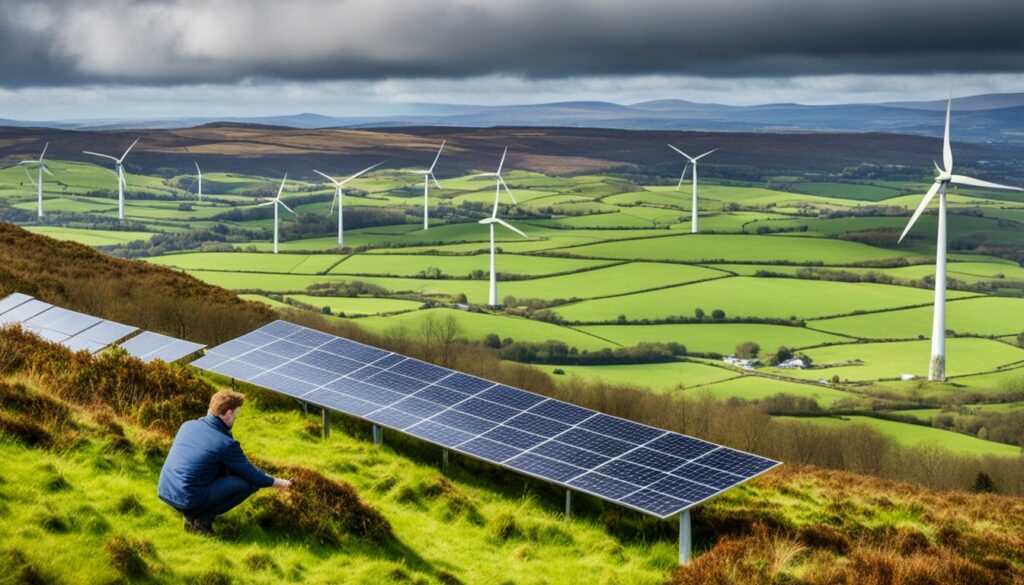
We aim to cut CO2 emissions by a huge 80% before 2050. This target covers areas like making electricity, building homes and offices, and how we get from one place to another. Each area has its own tough goals. These are thanks to the push for more renewable energy in a European plan. It wants Ireland to get 16% of its energy from places like the sun and wind by 2020.
Setting very clear goals for different sectors is key. For example, the tax on carbon has gone up to €26 for each ton. This move is expected to cut yearly emissions by 0.3 million tonnes. The plan is to slash gases by 7% every year from now until 2030. And in the end, it aims for our gas emissions to be zero by 2050.
Each sector has its own way to meet these goals:
| Sector | Target | 2019 Achievement |
|---|---|---|
| Electricity Generation | 16% from renewable sources by 2020 | 12% with 37.6% of electricity generated from renewable sources |
| Transport | Progress towards low carbon routes | Ongoing with specific adaptation measures |
| Residential | Reduction in CO2 emissions | Incorporating sustainable practices |
| Agriculture | Compliance with emissions ceiling | Focused on sustainable techniques |
The work doesn’t stop there. Since 2014, the Environmental Protection Agency (EPA) has backed over 190 projects on climate change. They’ve put in around €32 million. This shows Ireland is serious about going green. It’s about finding a balance between our economy and the earth.
Agriculture and how we use land are important topics in Ireland’s Environmental Protection Act (EPA). Farming covers almost 68% of the country. This act aims to find a balance between farming for food and protecting nature. It encourages farmers to use methods that help wildlife and lower pollution.
The rules in Ireland focus on using land in a way that lasts. They encourage ways of farming that cut down on harmful gases, keep soil healthy, and save water. Farmers are urged to do things like rotating what they plant, using fewer chemicals, and farming without chemicals.
Looking after the environment while farming is key. This helps nature and farming to keep going in a healthy way for the future.
Rules have changed a lot since 1990 to protect our land better. New urban areas have grown by 65%. This has mostly affected places where farmers grow food.
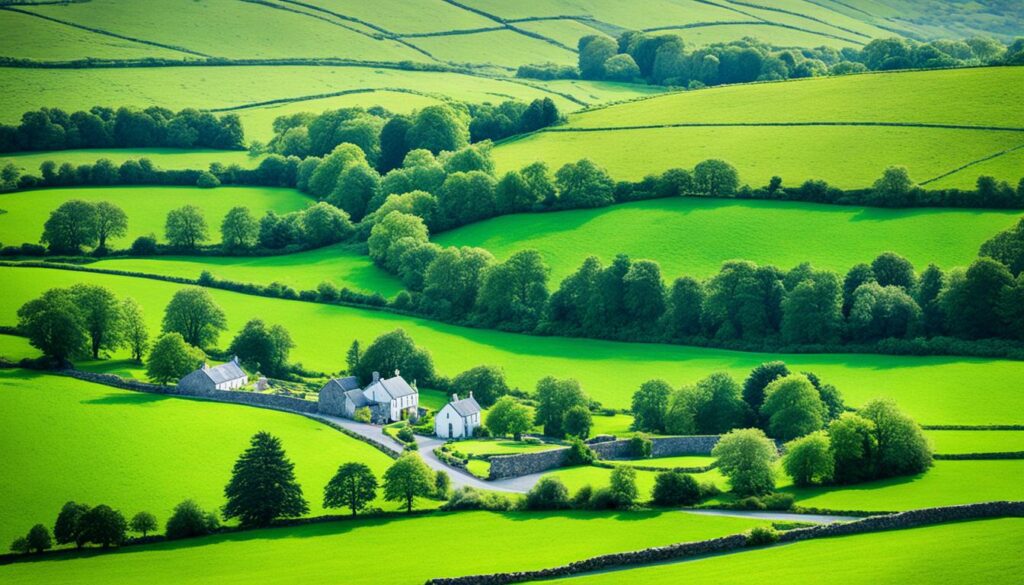
The act promotes fixing damaged areas and smartly growing more trees. By copying good ideas from around the world, Ireland is working towards better environmental practices.
These new rules hope to limit the bad effects of changing how we use land. They state we must handle waste well and clean up any pollution at official sites. Making a detailed map of the land helps everyone follow these rules better.
| Land Cover Type | Percentage of National Land |
|---|---|
| Agriculture | 67.6% |
| Wetlands | 14.9% |
| Forestry | 9.5% |
| Urban & Artificial Areas | N/A |
The changes in Ireland’s Environmental Protection Act show big steps in looking after the environment. These changes make Ireland more determined to fight climate change and ensure a green future. It’s worth noting that the country’s economy is strong, with a yearly GDP growth of 9% since 1994. This is thanks to booming electronics and pharmaceutical industries.To keep moving forward and tackle environmental challenges, Ireland must invest in its green infrastructure. This is very important for the country’s future.
It’s cool how Ireland is teaming up with the European Green Deal for a better environment. The EPA, or Environmental Protection Agency, was set up in 1993 to help with this. It’s now more independent and takes care of new rules making Ireland’s green scene better.
Now, let’s talk about future plans. Ireland should keep up funding, both from the government and private companies. Everyone needs to join hands and help the environment, as a law says.
More money should go towards fighting pollution – it’s crucial to keep Ireland’s promises about the environment. This way, Ireland can be a shining example in protecting our planet. So, the recent changes to the Environmental Protection Act are a bold move towards a strong, green future.
The recent changes in Ireland’s Environmental Protection Act focus on cutting carbon, growing in a sustainable way, and meeting tough new rules. By 2050, there’s an 80% cut in CO2 emissions. The law also demands using sustainable methods and penalises those who don’t.
The Ireland Environmental Protection Act is key for keeping our environment safe. It focuses on managing resources well, controlling pollution, and tackling climate change. Over time, it’s been updated to match local and European eco-friendly plans. These changes help fight climate change and support eco-friendliness.
The Environmental Protection Act in Ireland has been crucial in creating rules for limiting pollution and using resources wisely. Its changes show Ireland’s serious about handling growing environmental problems. It also shows a strong commitment to green goals locally and in Europe.
The latest changes put more focus on cutting down emissions. They encourage using cleaner technology and reducing our carbon footprint. To make sure everyone follows these new rules, there are punishments for not doing so. These rules help Ireland work towards its climate action aims.
Now, businesses, communities, and government bodies have to work towards less carbon use and more sustainable actions. If they don’t, they could face penalties. This is meant to get everyone to meet the new green standards. It pushes for better compliance with eco-friendly rules.
It focuses on controlling harmful substances, saving natural resources, and helping Ireland move towards a low-carbon economy. The aim is to create a lasting and strong environment that’s ready to deal with climate change.
The Act has changed to deal with hotter temperatures and more extreme weather events, like Storm Ophelia. It’s now focused on making our buildings and roads tougher against these events. Plus, it works to cut down on gases that warm up the planet.
Companies have to use cleaner tech, emit less carbon, and act more sustainably. Not following these new green requirements means facing penalties. These rules are set to make sure everyone is working towards a greener future properly.
Industries must now follow rules on emissions, waste, and using energy wisely. These rules help cut down environmental harm but still allow for economic growth. They encourage ways of working that are good for the planet in the long run.
EIAs check possible impacts of new developments on our environment. They are needed for many projects to make sure we’re making smart, green choices. This helps make development good for the planet’s future.
These plans guide our efforts in cutting emissions and making different sectors eco-friendlier. They set out clear steps and times on how to fight and adapt to climate change. The idea is to meet our green goals at home and abroad.
The Environmental Protection Agency (EPA) makes sure green laws are followed. It watches over emissions and supports research. It also encourages actions for the climate. This keeps our environmental efforts honest and on track.
The Irish Act works with the EU’s Green Deal for a planet-friendly future by 2050. The Deal’s goals, like protecting nature, affect Ireland’s own plans. This cooperation boosts efforts to be more eco-friendly in the future.
The Act values when the public and local groups help in deciding about the environment. Their views and efforts help make the Act more effective. This approach means we all work together for a healthier planet.
It lays out clear targets for different parts of society to promote a greener way of growing. These aims change how we develop, linking growth with keeping our planet safe. It helps us find better ways to use the land and resources.
The Act pushes for farming and land use to be more sustainable. It sets rules that balance production with looking after our planet. The aim is to farm and use land in ways that cut emissions and support nature, following world guidelines.